UPC J/psi in AuAu 200 GeV paper proposal
Title PRL:
Observation of strong nuclear suppression in exclusive $J/\psi$ photoproduction in Au$+$Au ultra-peripheral collisions at RHIC
Title PRC:
Exclusive $J/\psi$,$\psi(2s)$, and $e^{+}e^{-}$ photoproduction in Au$+$Au ultra-peripheral collisions at RHIC
PAs:
J. Adam, W. Schmidke, Z. Tu
Target Journals:
PRL+PRC
(A Letter + a long paper)
Abstract:
Exclusive coherent and incoherent \jpsi photoproduction in Au$+$Au ultra-peripheral collisions (UPC) are measured at $\sqrt{s_{_\mathrm{NN}}}=200$ GeV using the STAR detector. The measurement reports the differential cross section as a function of rapidity $y$ and \ptSquare of the \jpsi, where different combination of neutron emission associated with these processes measured by the zero degree calorimeter are also presented. For the first time at the top RHIC energy, the momentum transfer $-t$ of the \jpsi photoproduction is measured up to $2.2~\rm{(GeV/c)^2}$, where both coherent and incoherent production are included. Based on different neutron emissions of the Au nucleus caused by the Coulomb excitation, the coherent \jpsi total cross section of $\gamma^{\ast} + \rm{Au} \rightarrow J/\psi + \rm{Au}$ as a function of the photon-nucleon center-of-mass energy $W_{\rm{\gamma* N}}$ has been measured without photon energy ambiguities. In this Letter, the coherent and incoherent \jpsi cross section are found to be $40\%$ and $60\%$ suppressed when comparing to a free nucleon, respectively. Within the kinematic range $x_{\rm{parton}}\sim0.015-0.03$, the reported data provides an important experimental constraint for nuclear parton distribution functions. In addition, the incoherent \jpsi photoproduction has strongly suggested the presence of sub-nucleonic shape fluctuations in heavy nuclei, which is a major step forward towards understanding the initial-state dynamics of heavy-ion collisions. This measurement has also demonstrated the potential opportunities and challenges of performing gluon tomography measurement via coherent vector meson productions at the upcoming Electron-Ion Collider.
Conclusion:
In conclusion, we have measured differential cross section of \jpsi photoproduction in coherent and incoherent process as a function of rapidity $y$ and \ptSquare in \AuAu ultra-peripheral collisions (UPCs) at \sNNrhic~GeV. These cross sections are measured separately in different neutron emission classes, detected by the zero degree calorimeter (ZDC). In coherent \jpsi photoproduction, three different neutron emission classes, $0n0n$, $0nXn$, and $XnXn$, are combined to resolve the photon energy ambiguity in UPCs, which leads to the total cross section of \jpsi coherent photoproduction in $\gamma^{\ast}+$Au collisions as a function of per-nucleon center-of-mass energy, $W_{\rm \gamma^{\ast}N}$, for the first time. Data are found to be suppressed by 40\% compared to a free nucleon. In addition, the incoherent \jpsi photoproduction has been compared to that of a free proton based on the H1 data up to high \ptSquare of $2.2~\rm{GeV^{2}}$, where a stronger suppression than that of coherent production, $\sim60\%$, has been observed. The underlying mechanism of this stronger suppression in incoherent production can be qualitatively described by both the leading twist shadowing model and some saturation models. The parton density at the top RHIC energy sits at the transition region between large momentum quarks and low momentum gluons, which is essential to the understanding of both gluon saturation and nuclear shadowing mechanism. This data has not only provided important constraints to the parton density and its fluctuation, but also an essential experimental baseline for such measurement at the upcoming Electron-Ion Colliders.
PRL Figure. 0. Ultra-peripheral collisions at relativistic heavy ion colliders. (a) Coherent $J/\psi$ photoproduction in Au$+$Au collisions at $\sqrt{s_{_\mathrm{NN}}}=200$ GeV where the nucleus stays intact; Coulomb excitation can further break up the nucleus (not shown); (b) incoherent $J/\psi$ photoproduction where the leading nucleon stays intact but the nucleus breaks up; (c) incoherent $J/\psi$ photoproduction where the leading nucleon dissociates and the nucleus breaks up.

PRL Figure 1: Differential cross section $d^{2}\sigma/dp^{2}_{\mathrm{T}} dy$ of \jpsi photoproduction as a function of \ptSquare in Au$+$Au ultra-peripheral collisions at $\sqrt{s_{_{\rm{NN}}}}=200$ GeV. Four neutron emission classes, $all~n$, $0n0n$, $0nXn$, and $XnXn$ are shown in different panels. Coherent and incoherent template fits are shown as dashed lines, and the sum is shown as the solid line. Statistical uncertainty is represented by the error bars, and the systematic uncertainty is denoted as boxes.

PRL Figure 2: Differential cross section $d\sigma/dy$ for coherent (left), incoherent (right), and their ratio (bottom) of \jpsi photoproduction as a function of $|y|$ in \AuAu ultra-peripheral collisions at \sNNrhic~GeV. Statistical uncertainty is represented by the error bars, and the systematic uncertainty is denoted as boxes.

PRL Figure 3: Left: total coherent \jpsi photoproduction cross section as a function of \wGammaN in Au$+$Au ultra-peripheral collisions. The data are compared with the Impulse Approximation~\cite{Guzey:2013xba}, and the CGC~\cite{Mantysaari:2022sux}. Right: incoherent \jpsi photoproduction cross section as a function of \ptSquare is shown for $|y|<1.0$ in the all neutron class. The H1 data in $ep$ collisions, the BeAGLE model~\cite{Chang:2022hkt}, the LTA calculation~\cite{Guzey:2013jaa}, and the CGC prediction~\cite{Mantysaari:2022sux}, are compared with the STAR data. Statistical uncertainty is represented by the error bars, and the systematic uncertainty is denoted as boxes.

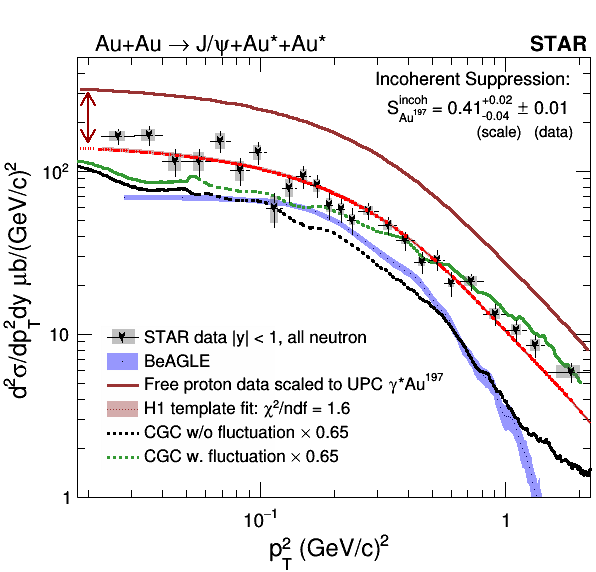
PRC Figure. 0. Ultra-peripheral collisions at relativistic heavy ion colliders. (a) Coherent $J/\psi$ photoproduction in Au$+$Au collisions at $\sqrt{s_{_\mathrm{NN}}}=200$ GeV where the nucleus stays intact; Coulomb excitation can further break up the nucleus (not shown); (b) incoherent $J/\psi$ photoproduction where the leading nucleon stays intact but the nucleus breaks up; (c) incoherent $J/\psi$ photoproduction where the leading nucleon dissociates and the nucleus breaks up.

PRC Figure. 1: Mass, $p_{\rm T}$, and rapidity $y_{\rm ee}$ of the electron pair candidates from UPC Au$+$Au collisions at $\sqrt{s_{_\mathrm{NN}}}=200$ GeV are shown in the left, middle, and right panel, respectively. Template fits from coherent and incoherent production, QED processes, and $\psi(2s)$ are included. Only statistical uncertainties are shown as error bars.
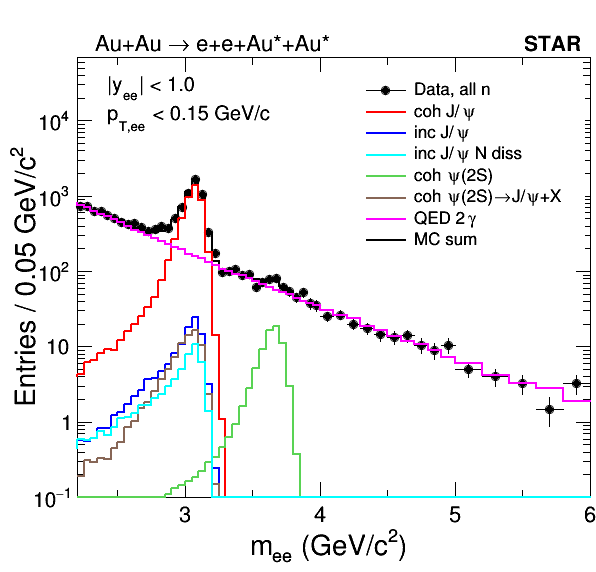
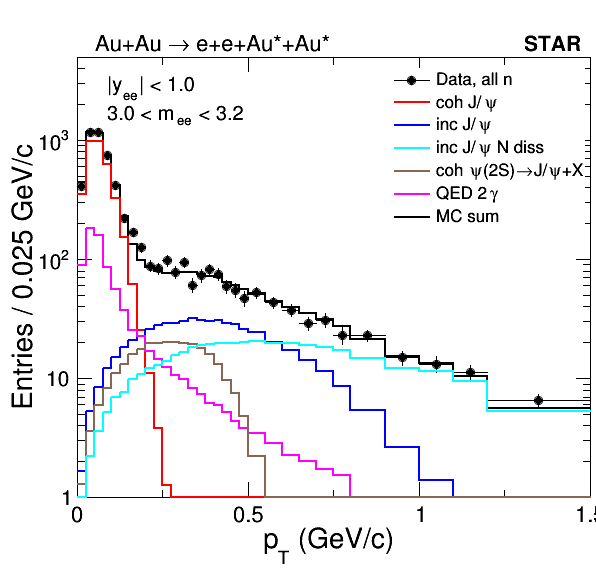
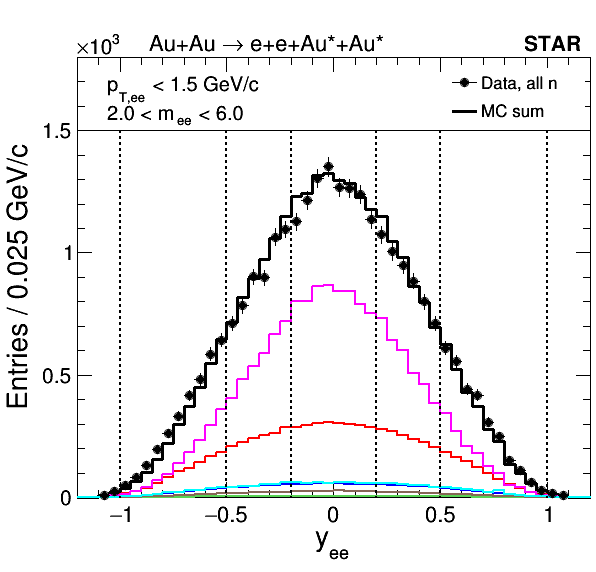
PRC Figure. 2: Invariant mass distribution of the electron pair candidates around $\psi(2s)$ mass window. Template fits including coherent $\psi(2s)$ and QED backgrounds are included. Only statistical uncertainties are shown as error bars.
.png)
PRC Figure. 3: Left: the Analog-to-Digital Count (ADC) distribution from Zero Degree Calorimeters (ZDC) in UPC Au$+$Au collisions at $\sqrt{s_{_\mathrm{NN}}}=200$ GeV. Right: the ZDC category in terms of how many neutrons (0 or X) are shown before and after overlap correction.
.png)
.png)
PRC Figure. 4: Differential cross section $d^{2}\sigma/dp^{2}_{\mathrm{T}} dy$ of \jpsi photoproduction as a function of \ptSquare in Au$+$Au ultra-peripheral collisions at $\sqrt{s_{_{\rm{NN}}}}=200$ GeV. The rapidity of the \jpsi is $|y|<1.0$ and averaged \wGammaN is 24.8 GeV. MC model STARLight (upper left), nuclear shadowing of leading twist approximation calculation (upper right), Sartre MC prediction (lower left), and the color-glass-condense prediction (lower right) are compared with the data, presented as lines. Statistical uncertainty is represented by the error bars, and the systematic uncertainty is denoted as boxes. Ratio between data and models are shown in the lower sub-panel of each figure.
.png)
PRC Figure. 5. Left: differential cross section, $d^{2}\sigma/dp^{2}_{\mathrm{T}} dy$, as a function of \ptSquare at very low \ptSquare with different rapidity $|y|$ bins in Au$+$Au ultra-peripheral collisions at \sNNrhic~GeV. STARlight events and color-glass-condensate calculations are compared with the data. Right: incoherent \jpsi photoproduction differential cross section, $d^{2}\sigma/dp^{2}_{\mathrm{T}} dy$, as a function of \ptSquare is shown for $|y|<1.0$ without neutron class requirement. The H1 data in $ep$ collisions, the BeAGLE model~\cite{Chang:2022hkt}, the LTA calculation~\cite{Guzey:2013jaa}, and the CGC prediction~\cite{Mantysaari:2022sux}, are compared with the STAR data. Statistical uncertainty is represented by the error bars, and the systematic uncertainty is denoted as boxes.

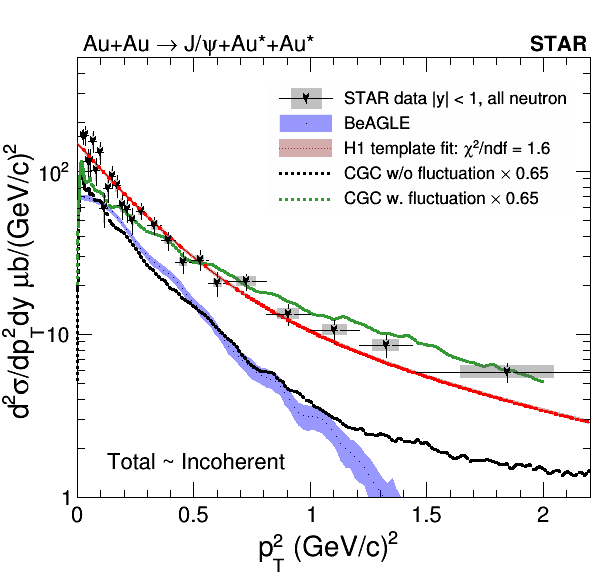
PRC Figure. 6: Differential cross section, $d^{2}\sigma/dp^{2}_{\mathrm{T}} dy$, of \jpsi photoproduction as a function of \ptSquare in Au$+$Au ultra-peripheral collisions at \sNNrhic~GeV with all neutrons and 0n0n configuration. Data are compared with BeAGLE simulation that has a STAR ZDC angular acceptance cut applied and the same neutron configurations. Statistical uncertainty is represented by the error bars, and the systematic uncertainty is denoted as boxes.
.png)

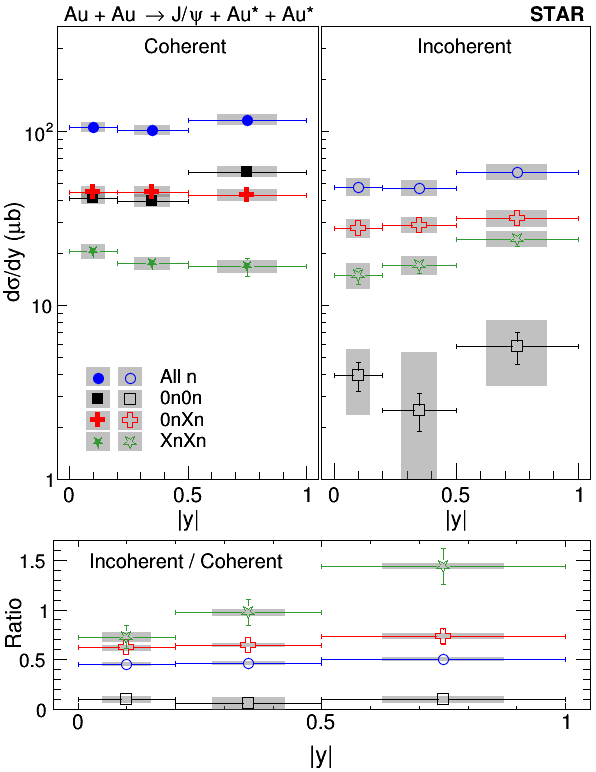
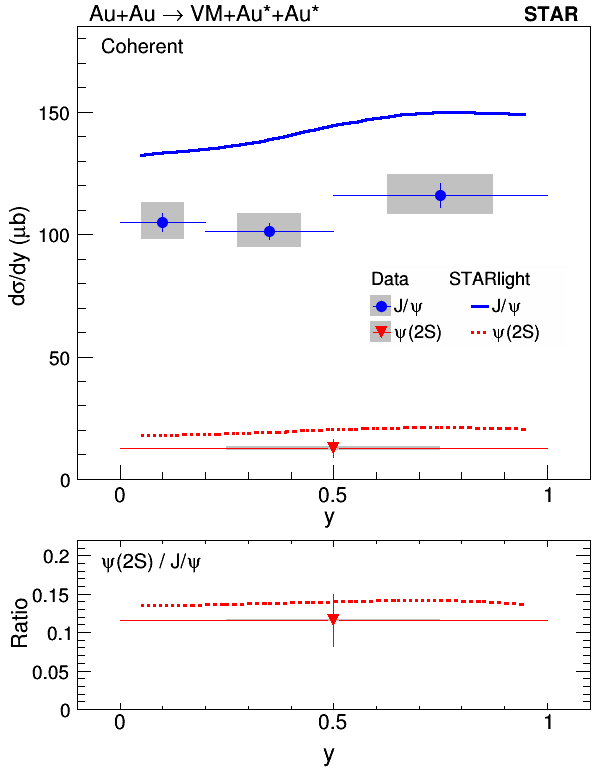
PRC Figure. 9: Total coherent \jpsi photoproduction cross section as a function of \wGammaN in Au$+$Au ultra-peripheral collisions. The data are compared with an expectation of a free nucleon provided by the Impulse Approximation~\cite{Guzey:2013xba}. Statistical uncertainty is represented by the error bars, and the systematic uncertainty is denoted as boxes.
.png)
PRC Figure. 10: Coherent and incoherent differential cross section, $d\sigma/dy$, as a function of $y$ of \jpsi photoproduction with 0nXn neutron configuration in Au$+$Au ultra-peripheral collisions at \sNNrhic~GeV. Here negative $y$ direction has zero neutron ($0n$) and positive $y$ direction has at least one neutron ($Xn$). BeAGLE model is compared with the data. Statistical uncertainty is represented by the error bars, and the systematic uncertainty is denoted as boxes.
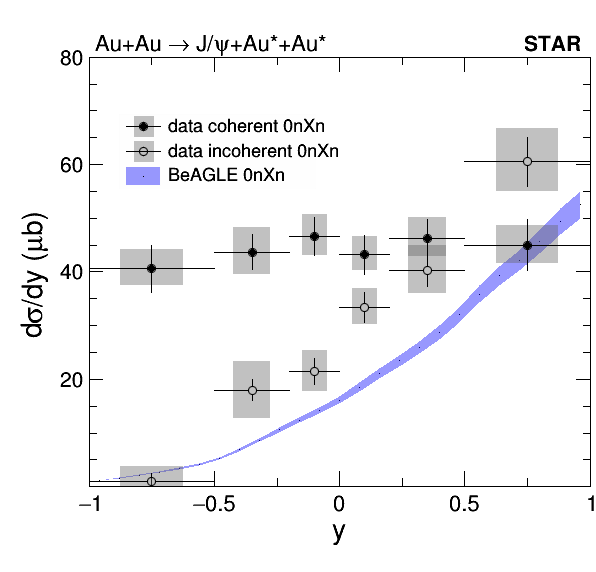
PRC Figure. 11: Differential cross section of exclusive electron pair production as a function of electron pair ($ee$) invariant mass in Au$+$Au ultra-peripheral collisions at \sNNrhic~GeV. The rapidity $y$ of the pair is within $\pm$ 1.0 unit, identical to that of the \jpsi particle. Model STARlight and QED theory calculations from Zha et al are compared with data. Right: the ratio between data and model/theory are shown. Statistical uncertainty is represented by the error bars, and the systematic uncertainty is denoted as boxes.
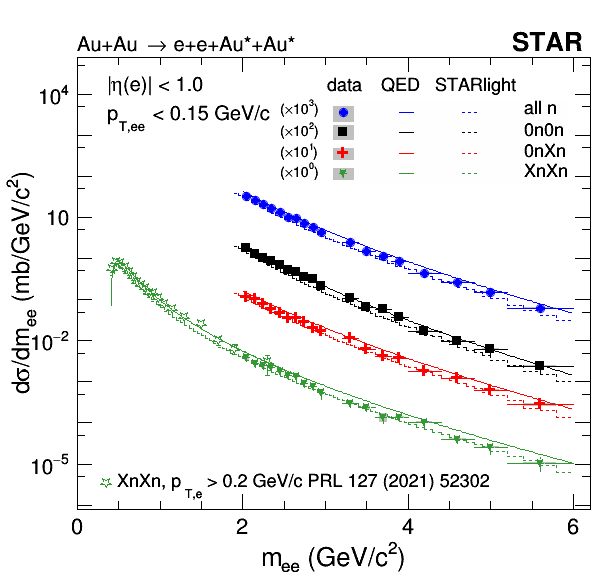
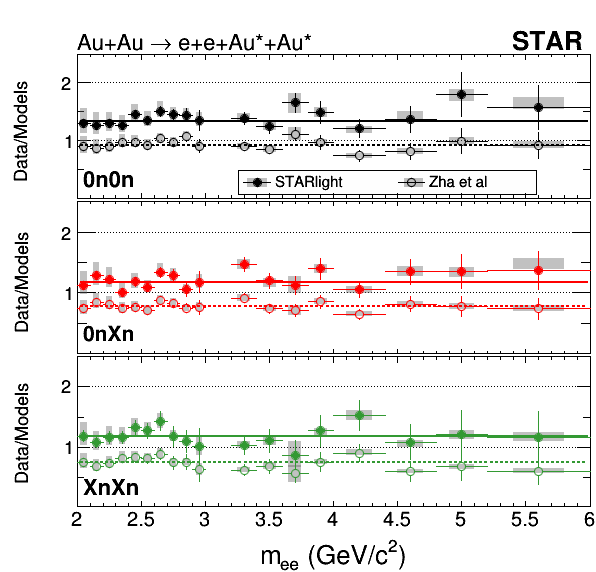
Relevant PWG presentations:
Analysis Note:
https://drupal.star.bnl.gov/STAR/blog/starkong/STAR-UPC-Jpsi-AuAu-Analysis-Note
Paper Draft:
https://drupal.star.bnl.gov/STAR/blog/starkong/STAR-UPC-Jpsi-AuAu-paper-draft
PWGC Preview Presentation:
https://docs.google.com/presentation/d/16PevwqWluR4vFmZECU8djwXRxlxo_3zOvGUnaw0Zn5g/edit?usp=sharing
PDF version:
https://drupal.star.bnl.gov/STAR/system/files/PWGC%20STAR%20AuAu%20UPC%20Jpsi.pdf
PWG Review:
https://drupal.star.bnl.gov/STAR/blog/starkong/PWG-review-response-April-30-2023
GPC presentation:
June 2, 2023: https://docs.google.com/presentation/d/113oD2bkAkbWEvi7mTqTpNgFdq38PbtM1_T_BhPoJnpo/edit?usp=sharing
Code for GPC
(currently it's under Kong's private github repo)
https://github.com/KongTu/star_auau_jpsi
GPC review:
1st round: https://drupal.star.bnl.gov/STAR/system/files/GPC%20%2523357%20comments_responses_PRL_June_28_2023.pdf
1st round with PRC: https://drupal.star.bnl.gov/STAR/system/files/GPC-%2523357-comments_responses_PRC_Aug_14_2023.pdf
2nd round with both PRC and PRL: https://drupal.star.bnl.gov/STAR/system/files/GPC_357_comments_responses_Aug_6_2023.pdf
Institutional review:
https://drupal.star.bnl.gov/STAR/system/files/GPC357InstitutionalReview.pdf
Referee report & response:
https://drupal.star.bnl.gov/STAR/blog/starkong/referee-response-GPC-357-1
- starkong's blog
- Login or register to post comments
